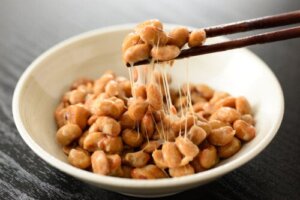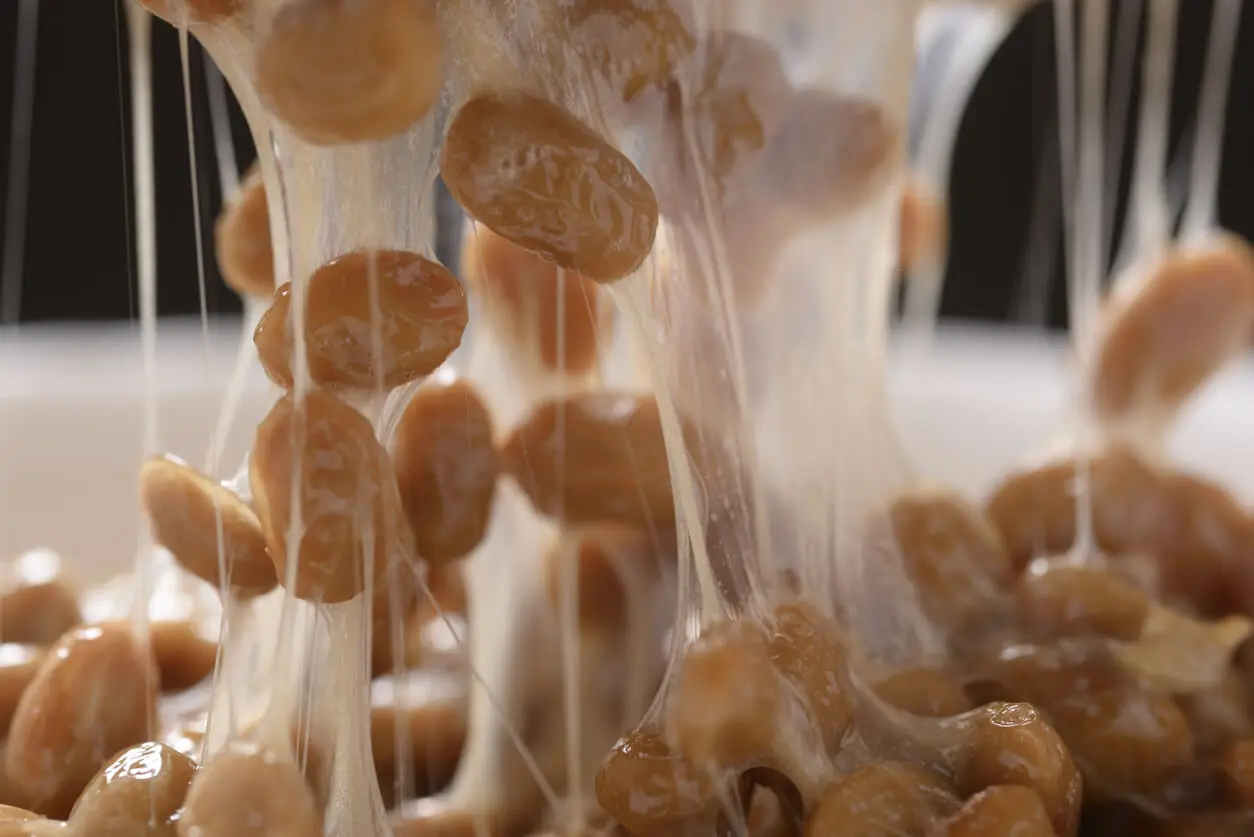Natto, the Viscous Japanese Food that Provides Probiotics


Written and verified by the nutritionist Maria Patricia Pinero Corredor
Natto is a Japanese food made from fermented soybeans with unique characteristics. It has an ammonia-like odor, a mucus-like consistency, and a taste that only 62% of Japanese people enjoy. However, being a fermented food, it has recognized health benefits.
This traditional food has three varieties:
- Hamanatto
- Itohiki
- Daitokuji natto
Hamanatto and daitokuji are prepared by adding mold for 24 hours. For itohiki, bacteria are added and it is cultured for 24 hours without adding salt.
Its main benefit is that it’s a probiotic. In this article, we’ll take a look at natto as a functional food. Don’t miss it!
What is natto?
Natto is a traditional Japanese food made from fermented soybeans. It’s not made with just any bacteria, however. Bacillus natto, which gives the product its name, is used to make this food. The soybeans are left with unusual sensory characteristics, which have made this food a bit controversial when it comes to taste.
Its texture is gelatinous, like a kind of slime or mucus. The smell is ammonia-like and it’s usually served separately in restaurants so as not to disturb the rest of the diners.
Although the taste is a little more pleasant than its smell, few people really like it. However, since it’s considered a beneficial food, there are many who consume it.
A 100-gram serving of natto provides the following:
- Calories: 211
- Protein: 19 grams
- Fat: 11 grams
- Sugar: 13 grams
- Fiber: 5.4 grams
- Complex carbohydrates: 4.9 grams
- Saturated fat: 1.6 grams
- Vitamin C: 13 milligrams
- Iron: 8.6 milligrams
- Potassium: 729 milligrams
- Calcium: 217 milligrams

We think you may be interested in reading this, too: What’s the Difference between Prebiotics and Probiotics?
A Japanese probiotic
When natto is made, whole soybeans are washed and soaked overnight in hot water. These seeds are then cooked for 20 to 30 minutes in a pressure cooker.
The cooked seeds are stored at 45 degrees Celsius before inoculating the probiotic bacterial strain. It’s then left to ferment for 18 to 20 hours.
Bacillus natto has been found in animal studies to have anti-inflammatory, antioxidant, enzymatic, and immunomodulatory properties. Furthermore, in a treatment for obese mice, the bacterium was able to diversify the intestinal flora of the subjects investigated.
However, it’s not only that. Natto also significantly reduced the body weight of the animals. In addition, their triglycerides and total cholesterol were lowered.
Moreover, it was found that this Bacillus worked as a probiotic when used in pig feed for 28 days. To confirm the theory, 90 pigs were fed Bacillus natto for 35 and 40 days. The authors of the publication emphasize the antibiotic potential, as the presence of the bacillus counteracted Escherichia coli.
However, not all studies were conducted on animals. Another more recent one looked at the effects on the human gut microbiota of consuming natto capsules.
It was found that there was a significant increase in bifidobacteria in the people studied. Bifidobacteria are microorganisms that inhabit the gut flora and are associated with overall good health. They can break down food and fight pathogenic microorganisms.
Like this article? You may also like to read: The Vertical Diet: What Is It and What Are Its Disadvantages?
Other benefits of natto
Natto also has other benefits, as it is considered a superfood. Let’s take a look in detail.
It may inhibit viral infections
In scientific studies, it was determined that patients treated with an extract of natto inhibited viral infections, such as severe acute respiratory syndrome due to coronavirus (SARS-CoV-2) and bovine herpesvirus 1 (BHV-1). According to the authors, this is achieved by degrading the viral particles.
Another study demonstrated how the enzyme nattokinase is able to destroy the S protein of the coronavirus. This protein is essential for the entry of the virus into cells. The analysis showed that the S protein on the cell surface was degraded when nattokinase was added to the culture medium.
It may be an alternative to address cardiovascular diseases
Research showed that nattokin, the most active ingredient in natto, has fibrinolytic activity as well as antihypertensive, hypolipidemic, antiatherosclerotic, antiplatelet, and neuroprotective effects.
Early studies indicated that nattokinase enhanced thrombolytic activities. In fact, it’s suggested that this is due to antithrombotic, anticoagulant, antioxidant, and lipid-lowering effects. Another study described how nattokinase supplementation 9 times daily was effective in suppressing the progression of atherosclerosis in patients with atherosclerotic plaques. Treatment with the compound lasted 26 weeks.
The effect of nattokinase on arterial hypertension has also been analyzed. Supplementation was applied for 8 weeks to patients with high blood pressure and it was concluded that both systolic and diastolic blood pressure were reduced.

How to make homemade natto
The Bacillus subtilis natto strain should be used in the preparation of natto because it’s the one that produces the unique and characteristic fermentation of the product. These ingredients are required for this purpose:
- Water
- 500 grams of soybeans
- 1 gram of Bacillus subtillis natto spores (or also 50 grams of natto that’s already been prepared)
To begin, all the instruments to be used must be boiled to avoid cross-contamination. Once this is done, the soybeans are soaked for 12 hours, although many recommend leaving them for up to a whole day.
When they are removed from the softening phase, they should be cooked for 15 minutes in a pressure cooker or over medium heat for 6 hours. After they’re cooked, remove them from the heat, drain them, and allow them to cool to room temperature. Then, they should be placed in a warm place until they reach a temperature of about 50 degrees Celsius. You will need a thermometer to measure this.
When they reach this temperature, then it’s time to add the bacteria. If you don’t have Bacillus natto powder, you can put 50 grams of prepared natto instead. Stir so that the bacteria is well integrated with the cooked soybeans.
Let it ferment at a constant temperature of 40 degrees Celsius for 24 hours. You can place it in the oven or in a yogurt maker to achieve the ideal fermentation.
When fermentation occurs, it’s ready to eat. However, many let it sit in the cold of the refrigerator for 1 to 3 more days.
All cited sources were thoroughly reviewed by our team to ensure their quality, reliability, currency, and validity. The bibliography of this article was considered reliable and of academic or scientific accuracy.
- Afzaal, M., Saeed, F., Islam, F., Ateeq, H., Asghar, A., Abbas Shah, Y., Ofoedu, C. E., & Chacha, J. S. (2022). Nutritional Helaht perspective of natto: a critical review. Biochemistry Research International. 5863887. https://www.ncbi.nlm.nih.gov/pmc/articles/PMC9616652/
- Capozzi, A., Scambia, G., Migliaccio, S., & Lello, S. (2020). Role of vitamin K2 in bone metabolism: a point of view and a short reappraisal of the literature. Gynecology and Endocrinology. 36(4): 285-288. https://pubmed.ncbi.nlm.nih.gov/31711322/
- Corliss, J. (24 de junio de 2019). Probiotics may ease constipation. Harvard Health Publishing. Harvard Medical School. https://www.ncbi.nlm.nih.gov/pmc/articles/PMC8285709/
- De Vos, W. M., Tilg, H., Van Hul, M., & Cani, P. D. (2022). Gut microbiome and health: mechanistic insights. Gut. 71(5): 1020-1032. https://www.ncbi.nlm.nih.gov/pmc/articles/PMC8995832/
- Food Data Central. (1 de abril de 2019). Natto. U. S. Department of Agriculture. https://fdc.nal.usda.gov/fdc-app.html#/food-details/172443/nutrients
- Gombart, A. F., Pierre, A., Maggini, S. (2020). A review of micronutrients and the immune system-working in harmony to reduce risk of infection. Nutrients. 12(1): 236. https://www.ncbi.nlm.nih.gov/pmc/articles/PMC7019735/
- Gopikrishna, T., Suresh Kumar, H. K., Perumal, K., & Elangovan, E. (2021). Impact of bacillus in fermented soybean foods on human health. Springer Nature. 71(1): 30. https://www.ncbi.nlm.nih.gov/pmc/articles/PMC8285709/
- National Institutes of Health. Office of Dietary Supplements. (24 de febrero de 2020). Vitamin K. https://ods.od.nih.gov/factsheets/VitaminK-DatosEnEspanol/
- Ortho Info. (Agosto 2021). Calcium, nutrition and bone health. American Academy of Orthopedic Surgeons. https://orthoinfo.aaos.org/en/staying-healthy/calcium-nutrition-and-bone-health/
- Qin, P., Wang, T., & Luo, Y. (2022). A review of plant-based proteins from soybean: health benefits and soy product development. Journal of Agriculture and Food Research. 7. 100265. https://www.sciencedirect.com/science/article/pii/S2666154321001678
This text is provided for informational purposes only and does not replace consultation with a professional. If in doubt, consult your specialist.








